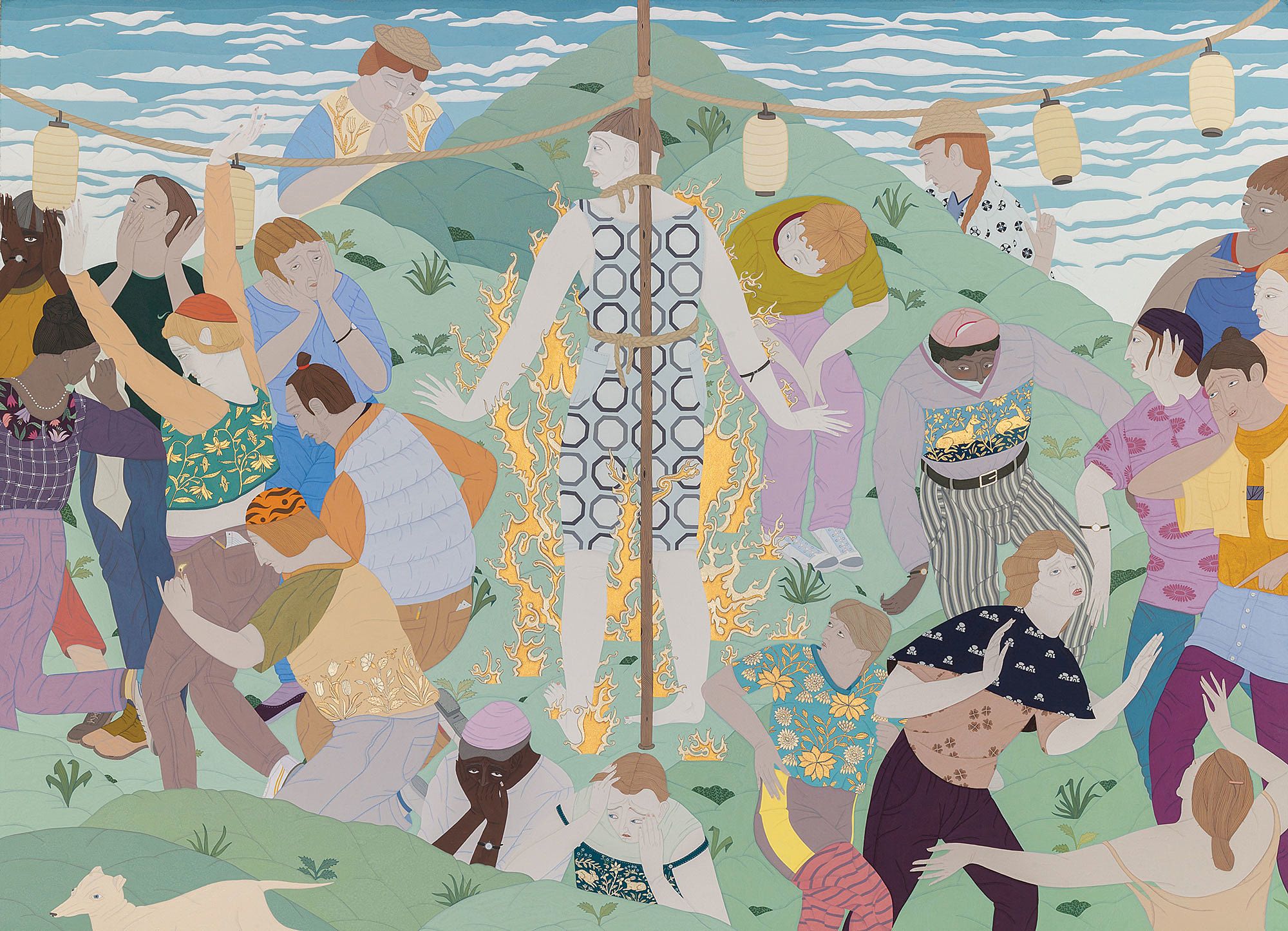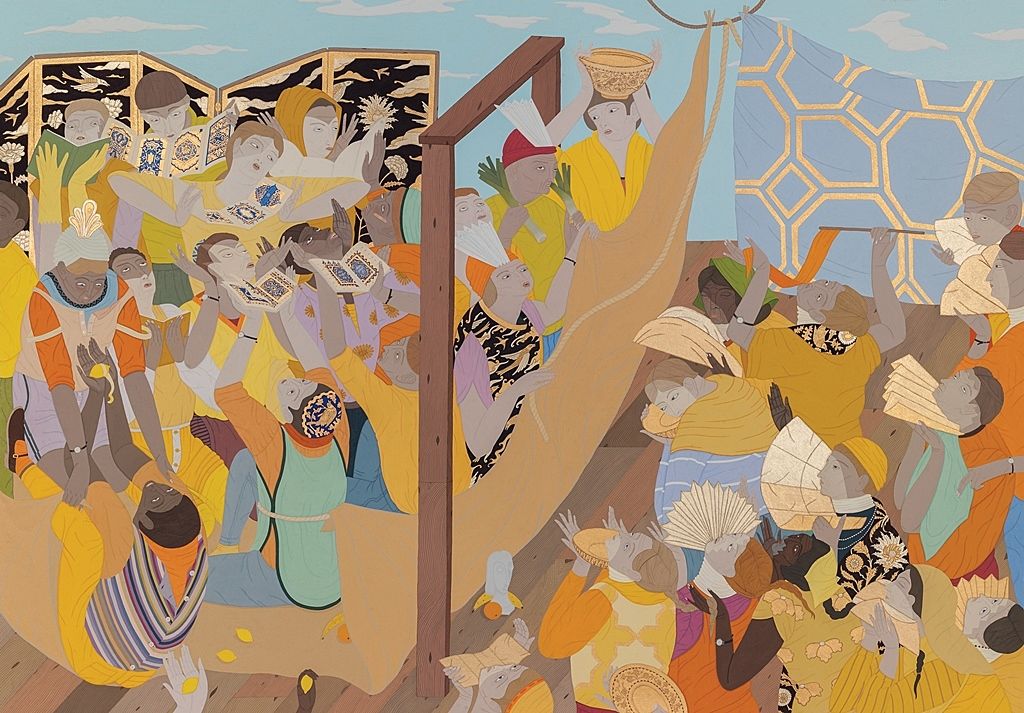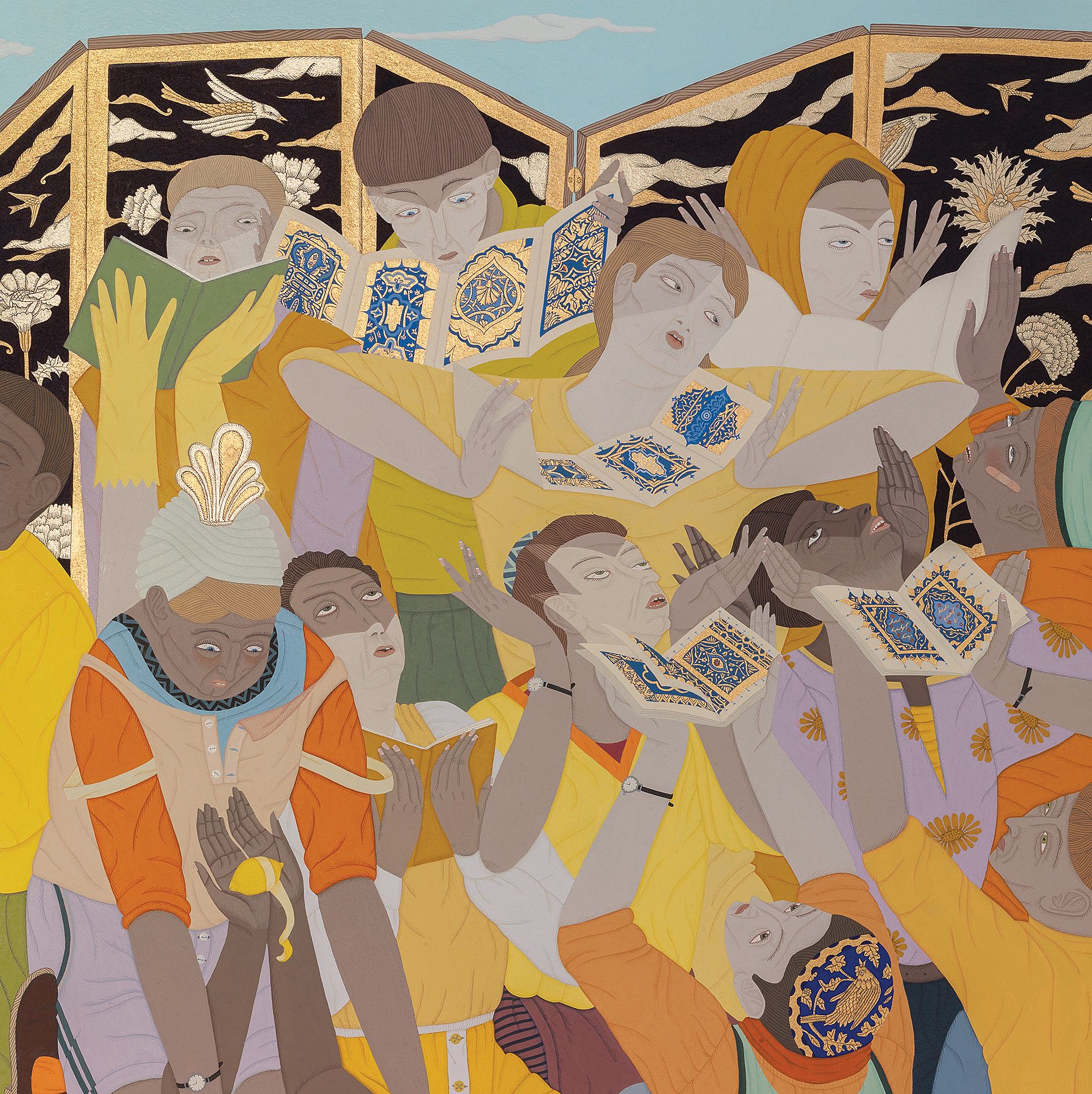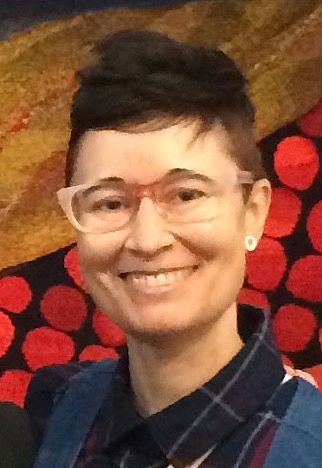The Heat of Ritual: A review of Kushana Bush's 'The Burning Hours'
Robyn Maree Pickens considers the immersive communities in Kushana Bush's exhibition at the Dunedin Public Art Gallery.
Robyn Maree Pickens considers the immersive communities in Kushana Bush’s exhibition at the Dunedin Public Art Gallery.
“Once a miniaturist’s artistry enters our souls this way, it becomes the criterion for the beauty of our world.”[i]
Outside my window chickens peck and strut among brilliant specks of yellow buttercups outshining the long green grass that runs down to the quiet tide. Spotted shags roost on the white guano tree, while kotuku (white heron) glide over black-robed Zen Buddhists who pace around the Lodge like coarse, slow finger pads rasping rosary beads. There is one bedraggled tramping shoe. I feel like I’m in a Kushana Bush painting, but I’m on Quarantine Island Kamau Taurua in the Otago harbour. Everything I have described is true, although I have moved the elements closer together than they are in real life.
Only two days ago – as we walked round Bush’s first major solo exhibition, The Burning Hours, at Dunedin Public Art Gallery – the artist told me that she was fearful of death, that ox gall was used by early miniaturists to bind the properties of gouache, that Persian miniaturists of the fourteenth-century preferred brushes made from the hair of six-week old white kittens, and that as a result of intense migraines she apprehends the brilliance of marigolds and buttercups in one eye as if trapped in a hallucinatory rapture.
It is a hallucinatory palette of buttercups, lemons, turmeric, ochre and gold (gold leaf) that dominates one of the key works in this extraordinary series, Shamsa (2016). It encapsulates many of the themes and developments of The Burning Hours, and indeed of Bush’s oeuvre since her trip to Dublin’s Chester Beatty Library in 2014. Stooping to view illuminated manuscripts it was on this trip that she experienced a type of spiritual revelation.
The Chester Beatty houses invaluable collections of European and Persian illuminated manuscripts rendered in gouache and gold leaf. Whether to Allah or Christ, these manuscripts are acts of intense devotion designed to approximate the radiance of heaven, or to ignite a rapturous spiritual experience for the reader. Both East and West favoured the combination of gouache and gold leaf to achieve an intensity of detail, richness of colour, precision, and the quite literally dazzling properties of gold.
In the low-light conditions of the Library, and due to the small scale of the illuminated paintings, Bush had to stoop, in an appropriately reverential gesture, to get a better look, to take in the detail. What she particularly observed was the complex compositional action that extended vertically and horizontally to the very edge of the page. It was this full use of a broad pictorial plane and the application of gold leaf that Bush took away from her visit to the Chester Beatty Library, and the incorporation of these techniques and methods have injected a lively fecundity, a new exuberance, and exclamatory reverence into her work. Yet these developments have not lessened the wry humour, the improbable jest, the welcome absurdities that Bush is renowned for.
They begin to wear wristwatches, artefacts give way to Adidas insignia and other commercial markers, while the still salacious figures become more sinuous, wear leotards, unite in synchronised movements, revel in their own patterns and that of their garments.
For those unfamiliar with Bush’s work, her early paintings, such as Slump (2007) feature anguished, primarily nude male and female figures situated in the centre of the composition with an assortment of artefacts, all of which hover in flattened perspectival space. The earliest figures appear moribund; a motley assortment of abject, broken, syphilitic, diseased and bandaged bodies surrounded by totems. Over time the lack-lustre, barely-alive horizontal figures assume sitting, squatting and standing positions, but they still carry the air of the damned with open flesh wounds and decorative Band Aids. In subsequent series (such as All Things to All Men, 2102), the figurative forms acquire clothing as a psychological tool (that registers pulling, tugging), and as a surface for ornate adornment. They begin to wear wristwatches, artefacts give way to Adidas insignia and other commercial markers, while the still salacious figures become more sinuous, wear leotards, unite in synchronised movements, revel in their own patterns and that of their garments. Their health has definitely improved over the past decade.
Then in the wake of the Chester Beatty illuminated manuscripts all the space that was empty becomes replete with figures, architectural elements, even hints of distant landscape in the receding three-dimensional pictorial space. Aside from the anchoring device of architectural supports and structures, the figures themselves feel more concrete, more absorbed into their surroundings, and they are predominately clothed, arrayed in an ornate decorative excess that would make William Morris blush. When they are naked it feels naughty that they are. Importantly, the post-Chester Beatty works (2014–16) exhibit an intoxicating yearning for some experience that will make them raise their hands in exaltation. They seek illumination.
The geometric patterns sheer into the supplicants’ faces, creating peaked shadows, oval areas and crinkle patterns on foreheads and sides of faces, resulting in a two-tone colouration of the worshippers’ faces.
It is this desire that Shamsa distils, yet also gently mocks. In a Kushana Bush painting chickens may squawk into a procession of solemn black-robed Zen Buddhist monks processing around a tumbledown Lodge while kotuku ride the currents above. In Shamsa the majority of the supplicants direct their almond-eyes upwards to the heavens or down to the treasures cupped in their hands. Those on the left raise holy manuscripts aloft, while the worshippers on the right hold sun reflectors beneath their chins.
Despite being separated by a timber hurdle and an elaborate swath of ochre cloth, the two groups are united by the brilliance of the reflections emanating from light falling on manuscripts and sun reflectors. The geometric patterns sheer into the supplicants’ faces, creating peaked shadows, oval areas and crinkle patterns on foreheads and sides of faces, resulting in a two-tone colouration of the worshippers’ faces. In some respects this two-tone effect amplifies the heterogeneous multitude of ethnicities that characterise Bush’s oeuvre. In a body of work concerned with the search for ritual, there is an undeniable potency in the intermingling of different ethnicities and for the often strange, bizarre, intentionally mismatched accoutrements and artefacts that symbolise craven desire, baleful jealousy, and burning reverence that creases the faces and bodies of these seekers.
It is fast becoming mythic that Kushana was named after the Kushans, a syncretic civilisation that thrived between the first and third centuries CE in what is now Tajikistan, Afghanistan and northern India, and was tolerant of many religious beliefs. In Bush’s child mind, her imagination yoked her whakapapa to the Kushan civilisation, to the coins of Hindu, Buddhist and Hellenic insignia that her father collected, and to other earlier European and Indo-Persian traditions of spiritual fervour and belief as illuminated by monks and miniaturists, Giotto, Piero della Francesca, and Japanese woodblock prints that she discovered initially via second-hand art historical texts.
To this rich, multi-ethnic, multi-religious art historical milieu, Bush incorporates personal experiences and responses to the large-scale, and often largely incomprehensible events happening in vivo overseas. The events of the world, such as the mass migrations into Europe, floggings, the persecution of albinos, find their way into her consciousness via the radio, which she listens to hour after hour in her Dunedin studio. The irony of Bush’s art is that the exquisitely rendered, heterogeneous communities, or villages of people she creates, only come into existence through hours of solitude in her studio. It is here that the art historical, the actual, the present, the faraway, and personal response are spun through Bush’s eclectic imagination, which Justin Paton accurately describes as one of the most idiosyncratically complete in New Zealand art since Bill Hammond.[ii]
Kushana Bush creates utterly immersive communities of people engaged in mysterious rites, rituals and behaviours that she renders in unbelievable detail and precision in one of the most demanding and least forgiving mediums: gouache.
Kushana Bush creates utterly immersive communities of people engaged in mysterious rites, rituals and behaviours that she renders in unbelievable detail and precision in one of the most demanding and least forgiving mediums: gouache. The Burning Hours is the result of two and a half years of intensive synthesis and labour in which Kushana Bush has manufactured ritual. It may be an uncertain ritual: why is a lemon with a coil of peel spooling down offered with rapture to another figure who clutches the garments of the lemon bearer as if they were the last human on earth? Why does another worshipper clutch a whole leek in each hand? Is the sun enough? Are the illuminated manuscripts enough? Will the two groups intermingle?
As with Shamsa, each painting in The Burning Hours offers up a similarly diverse array of questions with compositions, juxtapositions, narrative complexity, adornment and beauty so compelling that the only appropriate response is to bow as Bush did before the illuminated manuscripts in the Chester Beatty Library. It is only by bowing or kneeling, as I have done, that the viewer can appreciate the full radiance of the gold leaf. In these “burning hours”, the development of new rituals, as Bush suggests, may play an important role in navigating the tyrannies and travesties (human and ecological) that wear into our consciousness. But in so doing, one must be aware, as Bush manifestly is, of the ritualised violence that tends to accompany expressions of religious fervour. That is perhaps why a lemon with spooled peel is offered up, for the absurd is never remote from our most Serious Endeavours.
All images courtesy of the artist and the Dunedin Public Art Gallery.
Dunedin Public Art Gallery
3 December 2015 to 2 April 2016
[i] Orhan Pamuk, My Name is Red (New York: Alfred A. Knopf, 2001), 161.
[ii] Justin Paton, “Old Weird World We Live In”, in The Burning Hours: Kushana Bush (Dunedin: Dunedin Public Art Gallery, 2016), 40.



